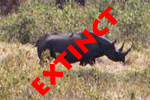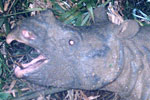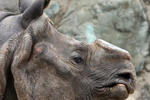Camera traps have successfully taken photos of 35 Javan rhinos (Rhinoceros sondaicus) in Ujung Kulon National Park. The small population, with an estimated 45 or so individuals, is the species’ last stand against extinction. Late last year, a subspecies of the Javan rhino, the Vietnamese rhino (Rhinoceros sondaicus annamiticus), was declared extinct.
The photos provided good news in that five of the rhinos photographer were calves, proving the rhinos were still reproducing effectively. However the photos also highlighted concerns: nearly 60 percent of the rhinos were males, meaning there is likely a sexual imbalance in the tiny population that could prove troublesome. Scientists are concerned that a lack of females could lead to fights between male rivals. In addition, four of the five calves were male.
Given a total population that certainly doesn’t exceed 60 individuals and is likely less, Javan rhinos are, not surprisingly, listed as Critically Endangered by the IUCN Red List. They are imperiled by poaching for their horns and habitat destruction, but perhaps even more dangerous in their case is that all the animals survive in one park, meaning a single natural disaster or disease could wipe them out. No Javan rhinos survive in captivity.
Indonesia has set a goal of increasingly the Javan rhino population to 70-80 individuals by 2015. They are setting up a 38,000 hectare rhino breeding sanctuary inside the park to help facilitate breeding among the species. The sanctuary will cover over 30 percent of Ujung Kulon National Park.
Across Asia and Africa, habitat destruction and poaching have pushed all five of the world’s rhino species, at one time or another, into endangerment. Rhinos are killed for their horns which are used in traditional Chinese medicine even though numerous scientific studies have shown the horns have no medicinal value whatsoever. Worldwide, rhino poaching has hit new highs recently, and it is believed a Javan rhino was killed for its horn last year (among one of three found dead).
Today, three of the world’s five rhino species—the black, the Javan, and the Sumatran—are listed as Critically Endangered. In addition to the Vietnamese rhino falling to extinction last year, 2011 also marked the official announcement that the western black rhino (Diceros bicornis longipes) was extinct.
Related articles
‘Christmas miracle’ for endangered rhinos
(12/24/2011) Conservationists and wildlife officials in the Malaysian state of Sabah airlifted a young female Sumatran Rhinoceros — one of the world’s most endangered animals — to an area of forest where she would encounter a potential partner, reports the Sabah Wildlife Department and Borneo Rhino Alliance. Sumatran Rhinoceros populations are so low, some individuals live in areas where they have no hope of ever finding another rhino.
A final farewell: the Western Black Rhino goes extinct

(11/12/2011) The western black rhinoceros (Diceros bicornis longipes) roams the woodlands of Africa no more. The rhino, one of four sub-species of black rhino, was declared extinct this week by the IUCN, five years after the last extensive survey of its habitat in Cameroon. The rhino becomes the second declared extinct this year. All rhinos are threatened by the rhino horn trade.
Malaysia must take action to avoid extinction of its last rhinos
(11/05/2011) Malaysia must take immediate action to prevent the extinction of the handful of rhinos that survive on the island of Borneo, says a coalition of environmental groups.
South Africa hits record poaching of rhinos—again
(11/03/2011) Two months before the end of the year, the number of rhinos killed for their horns in South Africa has surpassed last year’s breaking record, reports conservation organizations WWF and TRAFFIC. So far, 341 rhinos have been lost to poaching this year; while last year saw a total record of 333. The news follows last week’s announcement that the Vietnamese rhino (Rhinoceros sondaicus annamiticus), a subspecies of the Javan rhino, has gone extinct—the last individual killed by a poachers’ bullet. Rhinos are killed for their horns which are used in traditional Chinese medicine, even though numerous studies have shown there is no medicinal benefit to consuming rhino horn.
The last goodbye: Vietnam’s rhino goes extinct (PICTURES)
(10/26/2011) In 2009 poachers shot and killed the world’s last Vietnamese rhinoceros (Rhinoceros sondaicus annamiticus), a subspecies of the Javan rhino. The Vietnamese rhino was the last rhino species that survived on the southeast Asia mainland.

(10/25/2011) In 2009 poachers shot and killed the world’s last Vietnamese rhinoceros (Rhinoceros sondaicus annamiticus), a subspecies of the Javan rhino, confirms a report from International Rhino Foundation (IRF) and the World Wide Fund for Nature (WWF). The Vietnamese rhino was the last Javan rhino to survive on the Asian mainland and the second subspecies to vanish, following the extinction of the Indian Javan rhino (rhinoceros sondaicus inermis). The Javan rhino is the world’s most imperiled rhino species with now only around 50 individuals surviving in a single park on its namesake island in Indonesia.
Belief and butchery: how lies and organized crime are pushing rhinos to extinction

(05/11/2011) Few animals face as violent, as well organized, and as determined an enemy as the world’s rhinos. Across the globe rhinos are being slaughtered in record numbers; on average more than one rhino is killed by poachers everyday. After being shot or drugged, criminals take what they came for: they saw off the animal’s horn. Used in Traditional Chinese Medicine, which claims that it has curative properties, rhino horn is worth more than gold and cocaine on the black market. However, science proves all this cash and death is based on a lie. ‘There is no medicinal benefit to consuming rhino horn. It has been extensively analyzed in separate studies, by different institutions, and rhino horn was found to contain no medical properties whatsoever,’ says Rhishja Larson.